edgeFLEX starts a series of monthly insights of the project from the perspective of the project partners. Enjoy reading them.

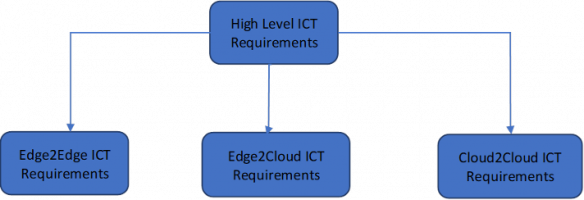
Inside edgeFLEX
Today: CRE
Supporting regulatory measures for smart grids and promoting flexibility
The energy sector is increasingly associated with the terminology "energy transition," and the main factors that determine and enhance this transition are the integration of renewable energy sources and digitalization. The smart grid concept par excellence is based on a series of real-time features and functionalities, by involving 5G technology, integration of algorithms for analysis and substantiation of decisions using big data, innovative services, and solutions to promote flexibility in the energy systems, responding to the challenges of managing the unpredictability of renewables.
The effective exploitation of this valuable source depends, to a large extent, on the quality of the data analysis, interpretation algorithms, and the associated ICT applications and cloud-based services for grid operation effectiveness and flexibility.
The development of such solutions and the wider analysis of their implementation framework, within the context of the edgeFLEX project, highlighted several aspects that need to be considered for facilitating the widespread adoption.
The edgeFLEX VPP2.0 solution, involving VPPs together with the energy communities in real time grid management and supporting flexibility, is part of the broader context of the digitalization of energy systems, consolidating the energy sector towards exploiting the huge potential of ICT real-time solutions, having an impact on better monitoring, control, and optimization of operations.
Whether we are referring to technical or market challenges, in the context of adopting and implementing smart grid solutions and promoting flexibility, the regulations in force can be both important obstacles and catalysts for the adoption of these solutions.
By default, and with technology advancement, the market reacts and proposes solutions to respond to these trends, but their adoption and implementation depends, to a large extent, on new measures and updates of the regulatory framework, such as:
- The ICT Network Code Continuum addressing missing ICT network code provisions
- A new ancillary service to address the growing need to provide inertia in the grid
- A new approach to local Voltage regulation based on integrating ICT solutions
- A Network Code (NC) for Demand-Side Flexibility (DSF) taking in small assets
- Network Code on Cybersecurity
Mihai Mladin


Inside edgeFLEX
Today: BAUM
How to ensure the survival of results after the end of a project
Making project results visible and further usable, especially after the end of a project, is difficult.
During a research project, the whole consortium works to get to the bottom of the original question, develops technical equipment and contributes to the solution of a problem. Technical devices can be sold and marketed after the end of the project. But what happens with the knowledge gained and the many insights?
Especially after the Covid pandemic and the whole world switching to remote it became very difficult to share the knowledge gained and make it available to a wide audience. No fairs, workshops or other big networking events could take place in person anymore.
Due to this drastic experience of a worldwide pandemic and the changed way of working, new ways had to be found in order to continue to exchange ideas on a professional level. The idea of a virtual exchange format was born, which among other things deals with one of the most important aspects of the energy transition - flexibility in the energy system.
Together with two other EU research projects, Platone and Fever, the FlexCommunity was founded. The big goal of this community is to be the knowledge platform when it comes to flexibility in the energy system. More than 200 registered members, several events, two big conferences and four different working groups are the results of the first year of the FlexCommunity. Since the founding projects only have a certain funding period, this project, which is not bound to any term, has created something that will continue to exist independently in the future. In addition to that, a platform was created, that is accessible to everyone interested in flexibility in the energy system, currently still with a focus on people form academia, industry and also form other research projects. With this platform, we ensure, that the knowledge gained in edgeFLEX and other projects is not disappearing, but is made accessible to the public.
Sarah Huber und Rita Dornmair
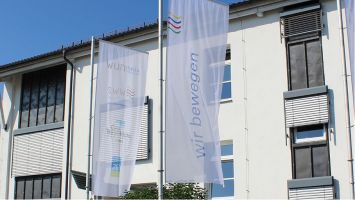

Inside edgeFLEX
Today: SWW
Beer, water and power – the role of energy supply in Wunsiedel
If I told you that the German trial site is doing testing of voltage control and reactive energy management, you would for sure say: “Sounds interesting… But what does this mean?” So let’s take a tour into the mysterious, complex and not so far away realm of electricity grids, where voltage and power rule alongside each other.
Let’s start by explaining what voltage is. Picture a water tank. To this water tank there are pipes connected to, which fill it to keep it to a certain level. Now you open the tap at the bottom of the tank and water comes out. The pressure of the water streaming out is comparable to the voltage in an electricity system.
If there is not the right water pressure – meaning that not enough or too much water leaves the tank – the system will collapse. You see, it is very important to keep the voltage within defined boundaries in order to maintain operational viability. Voltage control, thus, denotes actions performed for maintaining the voltage level of the system within these boundaries. In every realm there are rules.
As for the reactive power – one can look at it as a glass of fresh beer (not even science is safe when it comes to Germans’ favourite drink). The liquid itself, the strengthening hop juice every hero seeks, is the real or active power. The foam on top is a natural part of the beer but one cannot drink nor gain satisfaction from it. This is the reactive power – part of power generation, but not usable. However, something useless at first sight turns out to be necessary: it is essential for creating the electric current itself and keeping the electricity grid stable.
But as described above the electricity grid has its boundaries. Thus, reactive power needs to be reduced to a minimum which grants the stability of the grid as well as meets the demand of consumers at the same time.
But where is the connection to edgeFLEX? We build onto the previously implemented innovative energy management system infrastructure, laid out during the GOFLEX Project. This gave us the first foundation for enhanced control possibilities. During edgeFLEX, a new trading platform was established additionally enabling to host the existing capabilities alongside state-of-the art electricity monitoring devices, the edgePMU developed for this purpose within the project. The combination of new technologies in the German trial will be used to control voltage levels by monitoring power events. To do so, they send indications to the power trading platform to help reallocate energy in what is called flexibility. This helps us to manage the reactive power demand and to avoid costs by using renewable and decentralized energy units. So, basically, we combine voltage control, flexibility aggregation and reactive power management to improve the stability of the grid and to be as cost effective as possible.
Evyatar Littwitz and Sophia Rohbogner
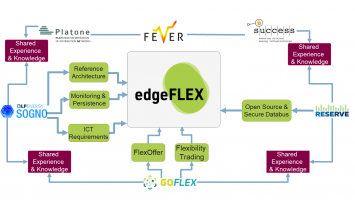
Inside edgeFLEX
Today: South East Technological University, SETU
The making of a platform
In the edgeFLEX project, we had the considerable challenge of delivering on the work that was scoped out before the COVID-19 pandemic in the new environment of remote and hybrid working. We were able to overcome this challenge by drawing on the previous work done within the Horizon 2020 programme as well as the considerable experience of the consortium members, allowing us to make efficient use of our time and resources. The fruits of these are evident in the development of the edgeFLEX platform.
The purpose of the edgeFLEX platform is to facilitate the deployment and interoperability of the diverse range of control services developed within the edgeFLEX project, which are focused on grid management, virtual power plant (VPP) optimisation and flexibility trading. Work on the platform began by defining a set of requirements from which software, communications and business architectures were created. Here, previous work was utilised as the reference architecture from the H2020 SOGNO project was extended to incorporate the concept of flexibility trading. This architecture was then refined to create the reference architecture from which the platform was developed. Although this work was carried out remotely, it proceeded in much the same way as it had before the pandemic, sans lively banter during coffee mornings.
Much like working remotely during the COVID-19 pandemic, communication is an important aspect of the edgeFLEX platform, as data must be received from remote trial sites to be utilised by the various services. Based on the communications architecture developed from the gathered requirements, the platform required a data bus service to enable data to be communicated between the services and field devices. An open-source application called DockerMQTT that was developed as part of the RESERVE project was utilised to this end. Open-source software has a large role to play in research in terms of generating valuable outputs and increasing transparency and reproducibility [1]. The storage and graphing of time-series data from the field was also developed based on work done as part of the SOGNO project. Development of the edgeFLEX platform benefitted greatly from the ability to expand upon software developed previously by project partners.
A large portion of the work in edgeFLEX took place in the backdrop of the pandemic, which brought about many challenges. Gone were the office talks and project meetups where people could meet face to face, instead these were replaced by Zoom meetings and in-depth technical discussions with the family pet. However, the edgeFLEX platform demonstrates that valuable work can be achieved in such a context and that a successful research project is built upon a foundation of previous work and experience, as well as on the body of established research. As one French writer, Jean-Baptiste Alphonse Karr once wisely said, “The more things change, the more things stay the same.” The mode of work may have changed, but research continues on as it always has.
Jack Jackman
[1] Barba, L.A. (2022) “Defining the role of Open source software in research reproducibility,” Computer, 55(8), pp. 40–48. Available at: https://doi.org/10.1109/mc.2022.3177133.
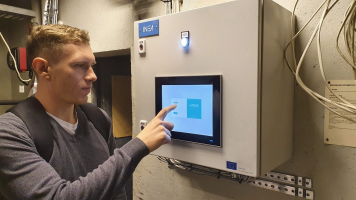
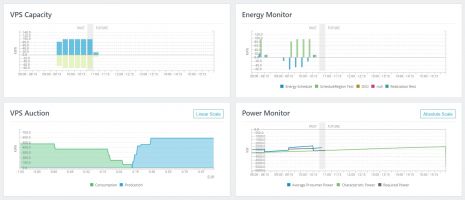
Inside edgeFLEX
Today: INEA
Reactive energy trading
One of the hurdles we, as a society, are facing is that as the number of intermittent power sources on the electrical grid is increasing, the predictability of available electrical energy decreases. This is driving the transition from consumption steering production to the opposite, production steering consumption. One way to get the most out of this phenomenon is to offer our flexibility in consumption or production to others. When there is a lack of energy in the grid, some parties would perhaps benefit more from the use of it than others would lose if they give it up. In such cases, we can all benefit with offering our energy as a flexible energy, so others can consume it instead.
For the edgeFLEX project, INEA is upgrading the concept of flexible energy trading, which was initially developed for active energy balancing, specifically voltage regulation on the distribution network. Voltage regulation is a more localized and dynamic challenge than energy balancing, where the issue can be tackled in a wider area with relatively slow dynamics.
This means that our solution for flexible energy trading is being upgraded to allow a more precise location description of the flexible energy sources and their influence on the nearby grid. The challenge of the faster dynamics requires rapid changes in production or consumption, meaning we are optimizing communication with the flexible energy-providing assets.
There is another type of energy flowing through the grid, which offers an alternative to voltage regulation on the distribution network. With the use of reactive energy injection, the grid voltage could be controlled similarly as with active energy. In theory, the injection of reactive energy into the grid affects the grid voltage, while other operational parameters stay unchanged. Same as flexible active energy trading for voltage regulation, our solution also allows flexible reactive energy trading for voltage regulation, while facing same challenges and some additional ones. For example, the production of active and reactive energy cannot be completely decoupled from each other. When an asset is producing active energy, it cannot produce an arbitrary amount of reactive energy. This, and other, challenges must be undertaken to effectively trade with both flexible energies, active and reactive.
Matija Arh


Inside edgeFLEX
Today: University of Bologna
What does a supermarket have in common with the trial in Italy?
Would you trust a supermarket using scales which provide results with variations of plus minus 100 g? Well, I may say yes if every time the scale error is in my favour. However, there is no need of experts to conclude that there is something wrong in those scales, or better, that those scales are inappropriate for the purpose.
The same concept can be extended – and it is applied everyday – to the electrical grid. The main difference is what we are measuring. We are not dealing with grams of tomatoes or litres of milk; instead, we are measuring voltages (V) and currents (A). These two quantities are then used to compute more complex ones like synchrophasors, powers, energies, etc. Another significant analogy with the supermarket is that we pay tomatoes as well as energy after the scale or the energy meter measured them. That is why it is crucial to perform accurate measurements.
That is the starting point of the Italian trial. Several commercial and prototype edge devices have been installed in the distribution network to achieve some important goals. First, a more observed network facilitates the distribution system operators work of controlling and managing it. Second, the capabilities of such edge devices trigger a variety of novel functions/algorithm like the voltage and frequency control, or the inertia estimation. Of course, these algorithms succeed only if the inputs they require can be trusted. Therefore, the trial exploits very accurate voltage and current sensors (imagine a scale that measures variations of 0.1 g).
In the specific case of the trial, the voltage control is implemented in the monitored portion of grid. Briefly, the voltage control takes hundred/thousands of “pictures” of the grid every second to assess its healthy. Afterwards, the voltage control algorithm can apply countermeasures to adjust the voltage in the “unhealthy” nodes. This smart control is possible if the voltage control algorithm has been given active access to the electrical assets of the grid. For example, renewable energy sources are connected/disconnected to increase/reduce the voltage of one or more nodes.
At the status of the trial, the biggest success has been to correctly integrate the commercial and prototype equipment with the existing one. Consider that system operators have really complex electrical and communication infrastructure, that typically is not built to accept new devices. Overcoming compatibility and communication issues is the perfect starting point of successful trial that will be completed in the following weeks.
Alessandro Mingotti
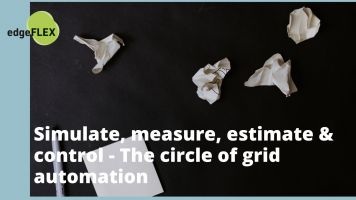
Inside edgeFLEX
Today: RWTH Rheinisch-Westfälisch Technische Hochschule Aachen
The new role of VPP foreseen in edgeFLEX of the Virtual Power Plant (VPP) requires the integration of grid automation solutions to support the System Operators in the management of the electrical grid. Since the beginning of the project it was clear that edgeFLEX required the investigation and the implementation of all the different aspects that characterize the grid automation system. These four aspects are: measure, estimation, control and simulation.
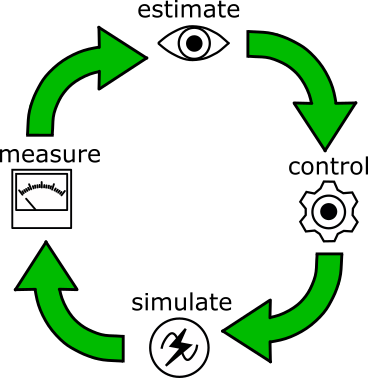
To perform any action on the grid, data must be acquired via measurement devices and sent to the servers that collect the set of data. Within the framework of edgeFLEX, the RWTH Aachen University has developed the edgePMU, to perform accurate and synchronized phasor measurements by collecting data on a low-cost device and performing processing in the edge cloud.
Consequently, power and frequency measurement data can be used to estimate the inertia of the system, providing hints for the Transmission System Operators (TSO) to assess the robustness of the grid.
Moreover, the collected measurements and estimated data can also be used for calculating the required control actions for the electrical grid.
Within the context of edgeFLEX, voltage control algorithms have been developed to manage the distributed generators installed in the distribution grid for maintaining the voltage within the technical limits.
All these three elements of the circle are meant to be applied in real grids, however, to test the algorithms and the communication interfaces, the real system is normally substituted with a simulated environment, which also allows the DSOs to perform critical tests on it.
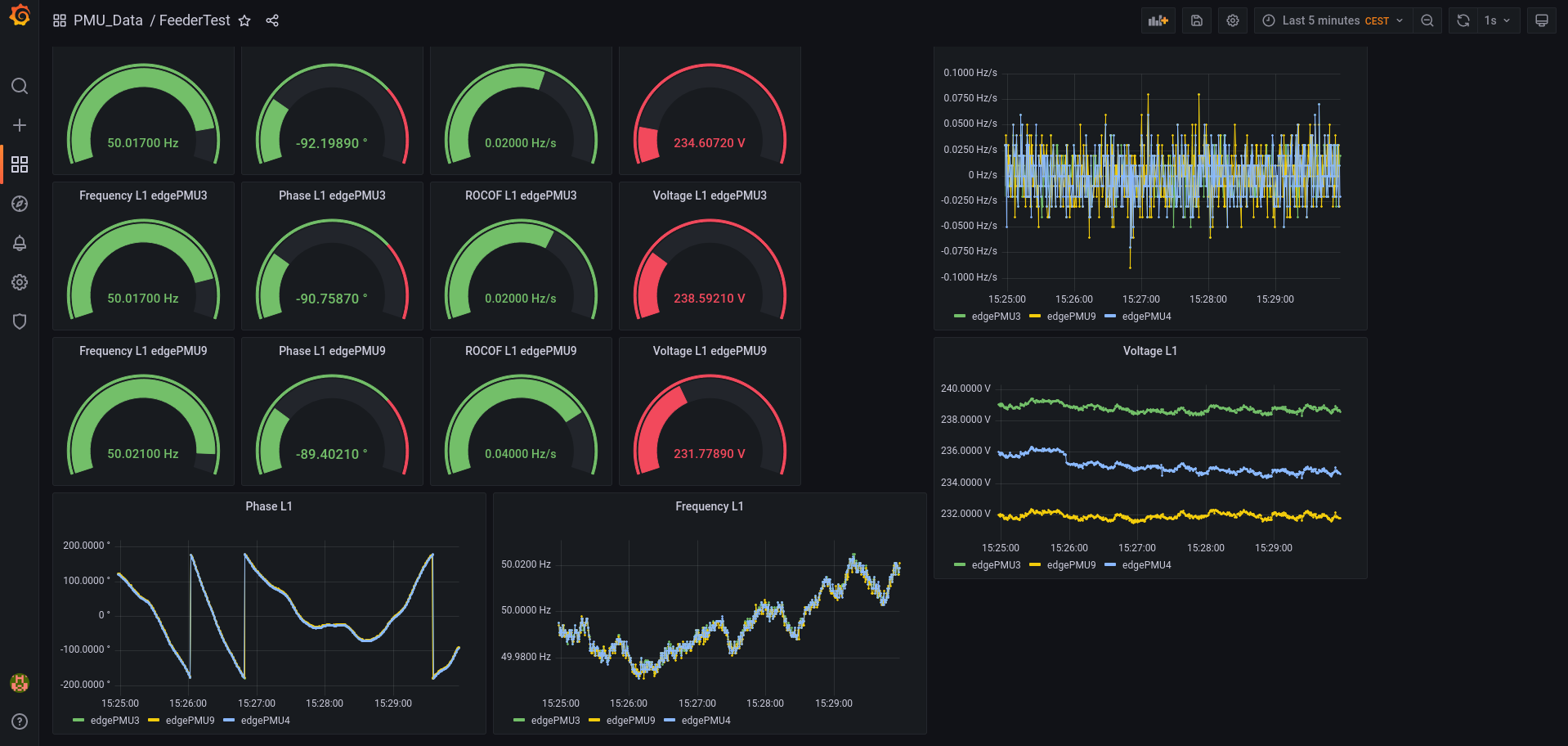
The development of all these aspects also brought with it some challenges. The installation of edgePMUs in the grid, for example, required understanding sensors and monitoring systems of the field trials. The control and estimation algorithms also needed a correct interface with the rest of the platform. Working on these challenges has helped RWTH increase its knowledge on aspects of devices deployment and integration with cloud platforms.
As a result, RWTH has been able to install and start collecting grid data from the field trials in Germany and Italy. Moreover, tests in a simulated environment have proven the ability of the control algorithms to be interfaced with edgePMU and use the measurements to calculate the correct set-points for the simulated grid.
Edoardo De Din, Gianluca Lipari, Jonas Baude und Diala Nouti
Inside edgeFLEX
Today: UCD
An inspirational story from the lockdown
The legend tells that Newton formulated the gravitational theory in 1665-66 after watching an apple fall. It is not a legend but probably less known that this discovery happened when Newton was at home, in Lincolnshire, as the University of Cambridge closed because of a bubonic plague epidemic. Newton himself described the two years he spent on lockdown as "the prime of my age for invention." With the due proportion and without any presumption of having discovered any fundamental principle of physics, I can now say that the two years that I spent mostly at home during the COVID19 pandemic has been an intense period of learning and discoveries for me too.
Staying at home, I did not have to commute to go to work and no students and colleagues were dropping by my office. And, as a consequence, there was much more free time. I dedicated this time to read, mostly mathematical books. Among these, the classical book “Differential Geometry” by J. J. Stoker. I was, at that time (end of 2020, beginning of 2021), elaborating on the definition of frequency and have just completed the paper “Complex Frequency” that was eventually published after two tough rounds of reviews on the IEEE Transactions on Power Systems.
When I started reading the book by Stoker, I was surprised to find a similarity between the formula of the curvature of a space curve and the expression of instantaneous frequency of an electric voltage in rectangular coordinates. The two expressions are, in fact, very similar except for the fact that the formula of the curvature uses the speed and acceleration of the position of a trajectory and has the unit of the inverse of a length, whereas the instantaneous frequency uses the voltage and its first-time derivative and has the unit of a frequency. For a while the similarity wandered in my mind just as an interesting oddity, but void of any implication.
It is not rare to find similar mathematical expressions in completely different disciplines. These similarities, in most cases, do not mean there is any actual link between the disciplines. Yet, the two formulas of curvature and instantaneous frequency were coming back to my mind suggesting that they were in effect linked through some deep bond. One day, thinking of Faraday’s law, which states that the voltage is the time derivative of the magnetic flux, I realized that, if the flux is associated to a trajectory, then the voltage is a speed. And that was it.
Prof Federico Milano

Representation of a trajectory of a generalised magnetic flux in a three-phase abc space. The tangent vector at any point P of the trajectory is the voltage v(t), and the normal vector is the derivative of the voltage with respect to the arc length v ̇(t) divided by the curvature κ(t). The local frequency of the voltage is given by w(t) = |v(t)| κ(t).
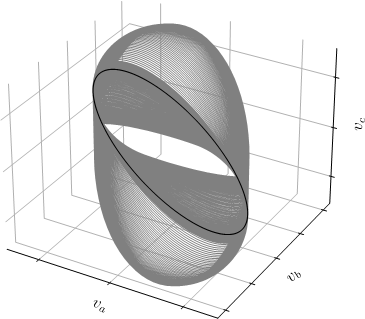
Trajectory of a voltage with time varying frequency in the three-phase abc space.
This simple assumption led to find that the “geometric frequency” of a voltage is in effect its curvature multiplied by the voltage magnitude. This fact has several implications. First, it generalises the concept of instantaneous frequency and solves the paradoxes to which the definition of this quantity leads. Second, it allows splitting the time derivative of the voltage into two terms: a translation and a rotation, which are useful for control applications. Third, it allows to generalize the Park transform, which is arguably the most important coordinate transformation utilised in power system dynamic analysis and control. Fourth, it provides the tools to design novel, simple, yet effective frequency and voltage controllers. Of course, this “discovery” does not have the depth and the tremendous impact of Newton’s gravitational theory. It is nevertheless a beautiful finding with several interesting applications. And it is comforting to think that this finding was given raise by the long quiet days during the various lockdowns and that not everything was bad about the pandemic.
Further reading:
- F. Milano, Complex Frequency, IEEE Transactions on Power Systems, vol. 37, no. 2, pp. 1230-1240, March 2022. arXiv: 2105.07769 DOI: 10.1109/TPWRS.2021.3107501
- F. Milano, A Geometrical Interpretation of Frequency, IEEE Transactions on Power Systems, vol. 37, no. 1, pp. 816-819, January 2022. arXiv: 2105.07762 DOI: 10.1109/TPWRS.2021.3108915
- F. Milano, G. Tzounas, I. Dassios, T. Kërçi, Applications of the Frenet Frame to Electric Circuits, IEEE Transactions on Circuits and Systems I: Regular Papers, vol. 69, no. 4, pp. 1668-1680, April 2022. arXiv: 2112.03633 DOI: 10.1109/TCSI.2021.3133948
- W. Zhong, G. Tzounas, F. Milano, Improving the Power System Dynamic Response through a Combined Voltage-Frequency Control of Distributed Energy Resources, IEEE Transactions on Power Systems, accepted in January 2022, in press. DOI: 10.1109/TPWRS.2022.3148243
- F. Sanniti, G. Tzounas, R. Benato, F. Milano, Curvature-Based Control for Low-Inertia Systems, IEEE Transactions on Power Systems, accepted in June 2022, in press. DOI: 10.1109/TPWRS.2022.3184189
- F. Milano, G. Tzounas, I. Dassios, M. A. A. Murad, T. Kërçi, Using Differential Geometry to Revisit the Paradoxes of the Instantaneous Frequency, IEEE Open Access Journal of Power and Energy, accepted in June 2022, in press. arXiv: 2206.12091
- F. Milano, The Frenet Frame as a Generalization of the Park Transform, submitted to the IEEE Transactions on Power Systems, under review. arXiv: 2206.09209
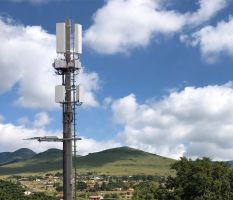
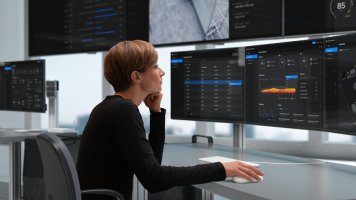
Inside edgeFLEX
Today: Ericsson
How 5G can better support power operators
With the dramatic growth of renewables, now is the time to revise the Virtual Power Plant (VPP) concept and this is the challenge edgeFLEX addresses. VPPs need to support not only the promotion of intermittent Renewable Energy Sources (RES) but also the integration of all Distributed Energy Resources (DER) into the full scope of grid operations. Such a leap is enabled by the new edgeFLEX architecture for VPPs in which communications, supported by 5G, correspond to multiple layers of dynamics, pave the way for a fully renewable energy system.
We are happy that we are currently planning a demonstration for an edgeFLEX stand at the EuCNC and 6G Summit conference in Grenoble in June! EuCNC will be our first edgeFLEX stand at a conference as the project started in April 2020 during the Covid-19 lock-downs. Despite everyone working from home and no face-to-face meetings being possible, the relationships between the project partners developed very well based on our many virtual meetings. We lightened up the isolated environment of the project partners with chocolates and tea packages sent directly to the homes of all project participants based in many different European countries!
On the stand at EuCNC, we plan to demonstrate results of our work in the project, such as those of our 5G latency tests. By runing laboratory tests in live 5G networks in Aachen, Germany, we investigated how 5G can support the edgeFLEX services. Additionally, we had the opportunity to try out the brand-new testbed for the new 5G feature Ultra-Reliable Low-Latency Communication (URLLC) which will provide even lower latency and higher reliability than currently available 5G versions.
Exposing 5G capabilities to vertical sector applications is a hot topic at the moment, and we in Ericsson were lucky to be able to investigate this topic for the power network domain and define the benefits and use cases for the exposed capabilities. In edgeFLEX, we are showing newly developed 5G enhancements providing VPP operators with the possibility to work together with Distribution System Operators (DSOs) enabling better monitoring and control and faster stabilisation of the power grid. The secure and reliable data exchange between the assets of VPP operators and the services of DSOs can be enabled by exposing 5G capabilities through new exposure capability interfaces. These interfaces can help VPPs and DSO’s to integrate 5G more easily and quickly in their existing infrastructure reducing their monitoring, control, and trading challenges. Thus, 5G will not only be able to support the existing needs of the power operators, additionally it will also enable new business cases in the coming years for the sector actors in the power domain!